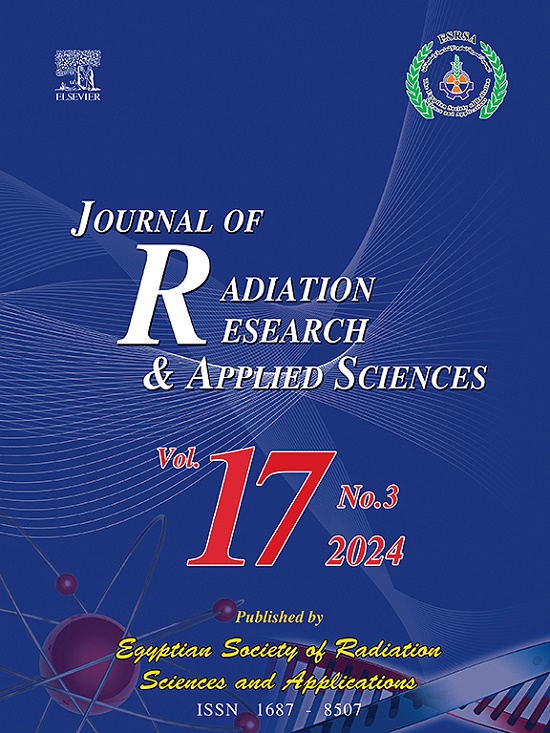作为伽马射线屏蔽的智能聚合物:屏蔽性能的实验评估
IF 2.5
4区 综合性期刊
Q2 MULTIDISCIPLINARY SCIENCES
Journal of Radiation Research and Applied Sciences
Pub Date : 2025-03-08
DOI:10.1016/j.jrras.2025.101398
引用次数: 0
摘要
这项研究的发现将进一步加深我们对智能聚合物增强伽马射线屏蔽的潜力的理解,这将为开发更高效、适应性更强、重量更轻的保护材料带来新的机会。这项工作研究了六种不同类型的智能聚合物对伽马和中子的屏蔽性能:聚氨酯、碳化硅、聚丙烯、聚四氟乙烯、聚偏氟乙烯和聚偏氟乙烯-共六氟丙烯。我们利用NaI (Tl)闪烁探测器和WinXCom工具计算了质量衰减系数(MAC)。然后用MAC计算线性衰减系数(LAC)、半值层和十值层(HVL &;在122 - 1330kev能量范围内,总光子相互作用的平均自由程(MFP)和有效原子序数(Zeff)。此外,还计算了快中子的宏观有效去除截面∑R。聚氨酯表现出最高的质量衰减系数(在122 keV时为0.141 cm2/g)和更快的中子去除截面(0.12 cm−1)。这一特性强调了它在衰减伽马和中子辐射方面的优越性能。实验与理论质量衰减系数值的相对差值表明,差异在1% ~ 5%之间,理论与实验结果具有显著的一致性。本文章由计算机程序翻译,如有差异,请以英文原文为准。
Smart polymers as gamma ray Shields:Experimental evaluation of shielding performance
The findings of this study will further our understanding of the potential of smart polymers to enhance gamma ray shielding, which will lead to new opportunities for the development of protective materials that are more efficient, adaptable, and lightweight. This work has investigated the shielding properties against gamma and neutrons of six different types of smart polymers: polyurethane, silicon carbide, polypropylene, polytetrafluoroethylene, polyvinylidene fluoride, and poly (vinylidene fluoride-co-hexafluoropropylene). We have calculated the mass attenuation coefficient (MAC) using the NaI (Tl) scintillation detector and the WinXCom tool. The MAC is then used to calculate the linear attenuation coefficient (LAC), half and tenth value layer (HVL & TVL), mean free path (MFP), and effective atomic number (Zeff) for total photon interaction over the 122–1330 keV energy range. Furthermore, the macroscopic effective removal cross-sections (∑R) for fast neutrons were calculated. Polyurethane exhibited the highest mass attenuation coefficient (0.141 cm2/g at 122 keV) and a quicker neutron removal cross-section of 0.12 cm−1. This characteristic emphasizes its superior performance in attenuating gamma and neutron radiation. The relative differences between experimental and theoretical mass attenuation coefficient values indicate that the discrepancies range from 1% to 5%, with noteworthy agreement between theoretical and experimental results.
求助全文
通过发布文献求助,成功后即可免费获取论文全文。
去求助
来源期刊

Journal of Radiation Research and Applied Sciences
MULTIDISCIPLINARY SCIENCES-
自引率
5.90%
发文量
130
审稿时长
16 weeks
期刊介绍:
Journal of Radiation Research and Applied Sciences provides a high quality medium for the publication of substantial, original and scientific and technological papers on the development and applications of nuclear, radiation and isotopes in biology, medicine, drugs, biochemistry, microbiology, agriculture, entomology, food technology, chemistry, physics, solid states, engineering, environmental and applied sciences.
 求助内容:
求助内容: 应助结果提醒方式:
应助结果提醒方式:


